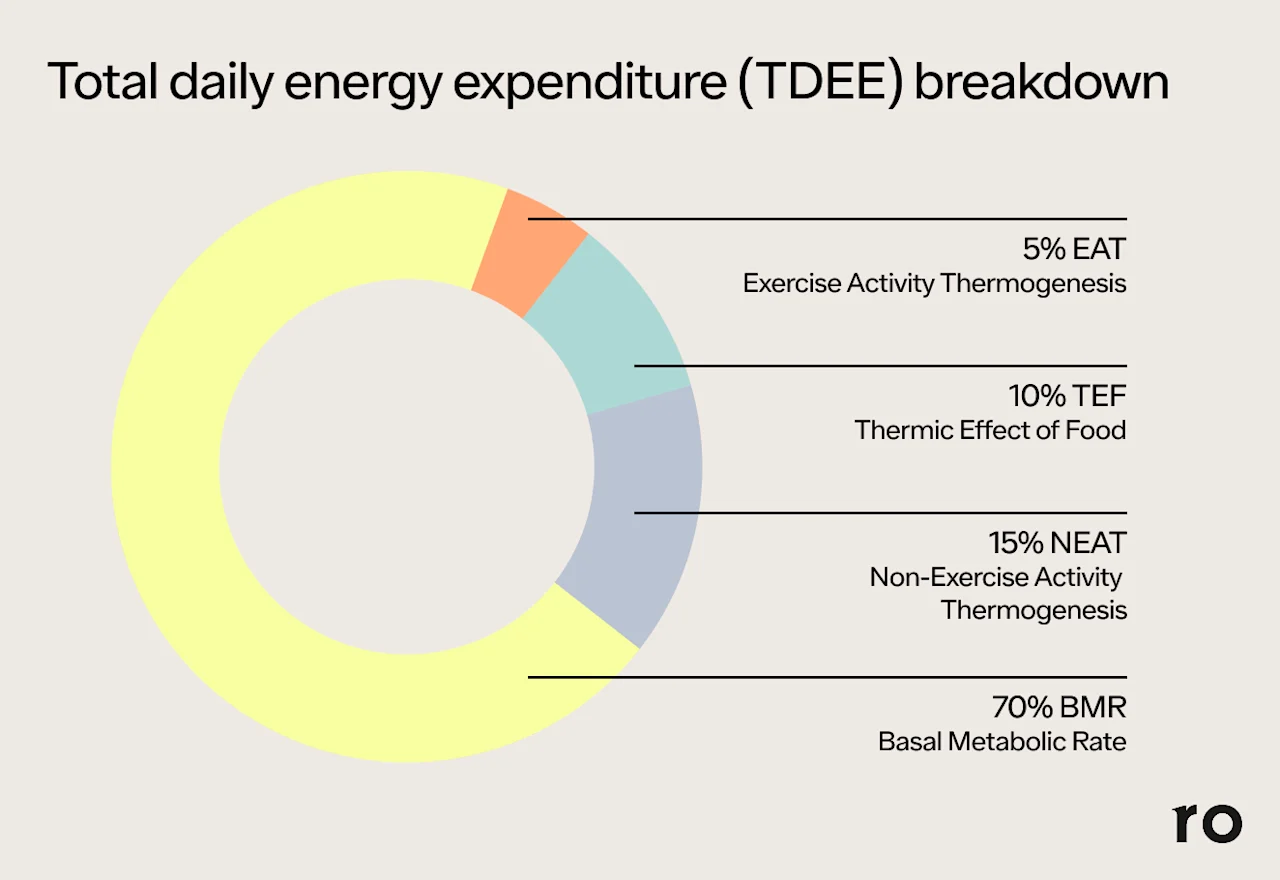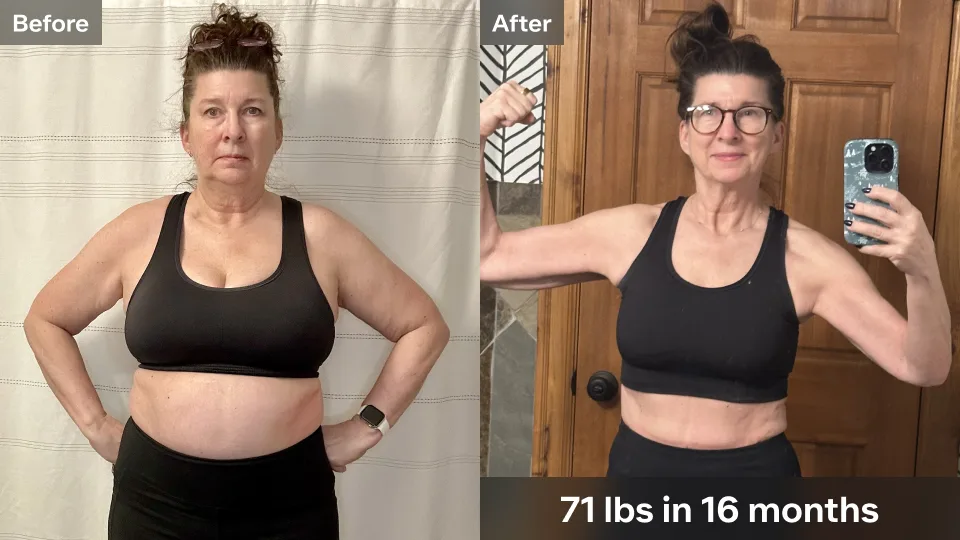TDEE Calculator
Total daily energy expenditure (TDEE) is the number of calories you burn in a day based on age, activity level, sex, weight, and height. Knowing your TDEE can help you understand how many calories you need to maintain, lose, or gain weight. Find out now.
Maintain your current weight
----
CAL DAILY
Lose one pound per week
----
CAL DAILY
This TDEE calculator is for informational purposes only and not a substitute for medical advice. Individual needs vary. Consult a healthcare provider before making changes. Eating fewer than 1,200 (women) or 1,500 (men) calories a day is not recommended.
What is TDEE?
Total daily energy expenditure (TDEE) is an estimate of the total number of calories you burn in a day. This includes all the energy your body uses daily, from keeping your heart beating to processing food.
TDEE is made up of three main components: basal metabolic rate (BMR), activity level, and thermic effect of food (TEF).
1. Basal metabolic rate (BMR): BMR is the amount of energy your body needs at rest to maintain vital functions like breathing and blood circulation. It’s based on factors, such as:
Age
Sex
Body composition (i.e. height, weight)
BMR accounts for approximately 60%–75% of your TDEE.
*Note: While often used interchangeably with resting energy expenditure (REE), BMR is a more accurate measurement of metabolism, primarily determined by your fat-free mass (e.g. muscle, bone).
2. Activity level: Activity level refers to all the energy you burn through movement, whether that’s structured exercise or daily activities (e.g. walking the dog). The more active you are, the higher your TDEE will likely be.
Your activity level can be divided into two components:
Exercise activity thermogenesis (EAT): This is the number of calories burned during intentional exercise, such as running or weightlifting. In other words, activities you do to purposely increase your heart rate. EAT generally contributes 5%–15% of TDEE, depending on the frequency and intensity of exercise. It can contribute a higher percentage in those who exercise far more.
Non-exercise activity thermogenesis (NEAT): This is the amount of energy used during non-exercise activities, such as walking, typing, or fidgeting. Think: the physical activity of daily life.
NEAT can account for 15%–30%+ of TDEE and, like EAT, can vary widely based on lifestyle and occupation.
3. Thermic effect of food (TEF): TEF describes the number of calories burned during digestion, absorption, and metabolism of food. It accounts for about 8%--15% of TDEE, depending on the specific macronutrients consumed.
Protein forces your body to burn 20%--30% of the calories from the protein.
Carbohydrates: 5%–10%
Fat: 0%–3%

*Note: Exact percentages are subject to vary depending on the person and daily activities.
How to calculate TDEE
To calculate your TDEE, you essentially multiply your BMR by your activity level.
Step 1: Estimate your BMR
To do this, you can use a few different equations, including the Harris-Benedict equation and the Mifflin-St Jeor equation. Of these, the Mifflin-St Jeor is considered the most reliable and most commonly used today.
Here’s the formula:
Females: (10 X weight [kg]) + (6.25 X height [cm]) – (5 X age [years]) – 161
Males: (10 X weight [kg]) + (6.25 X height [cm]) – (5 X age [years]) + 5
Step 2: Determine your activity level
When selecting an activity multiplier, think about how much you move throughout the day, both at work (or school) and at home.
Completely sedentary (chair- or bed-bound): 1.2
Lightly active (seated job, little to no strenuous physical activity outside of work): 1.4–1.5
Moderately active (seated job with some movement, maybe some physical activity outside of work): 1.6–1.7
Active (standing job, physical activity outside of work): 1.8–1.9
Very active (strenuous work, highly active outside of work): 2.0–2.4
Step 3: Multiply your BMR by activity level
…and, voilà, you have your TDEE.
So, if your BMR is 1,410 (i.e. the average BMR of a female adult, per the Cleveland Clinic) and you’re moderately active, your equation should look like this:
1,410 X 1.6 = 2,256 calories
How is TDEE related to weight?
To lose weight, your body needs to burn more calories than you take in — aka a calorie deficit. Your TDEE tells you how many calories you burn daily to maintain your current weight.
So, knowing your TDEE can help you plan: to lose weight, you’ll need to eat fewer calories than that number and/or be more active.
However, focusing solely on calorie restriction isn’t always practical or sustainable. That’s why it can help to look at ways to boost both your EAT and NEAT and prioritize healthy lifestyle habits, including nutrition and hydration.
How to increase TDEE for weight loss
You can increase your TDEE through simple (and sustainable!) daily strategies that support your weight loss goals.
Regularly exercise. In other words, increase your EAT. Staying active can reduce the number of calories you need to cut, making it easier to meet your nutrient needs and maintain progress. Strength training, in particular, helps build muscle mass, which is known to raise your BMR.
Move more overall. Even small increases in daily movement can make a meaningful impact. One study found that using a chair that encourages fidgeting (such as one with a leg bar) can boost TDEE by up to 30%. Other simple strategies include parking in the farthest spot so you have to walk more and taking the stairs instead of the elevator.
Eat a healthy diet. Research shows that pairing regular exercise with a healthy diet is the most effective way to lose weight and keep it off. Prioritizing lean proteins, whole grains, and fiber-rich foods supports a higher TEF. Protein, for example, requires more energy to metabolize than carbs or fat, which can slightly boost TDEE. It can also help you build muscle, another tactic for increasing TDEE.
Stay hydrated. Sipping on cold water and other zero- or low-calorie beverages (e.g. sparkling H2O) may temporarily bump up your BMR and TEF. This can slightly increase your TDEE. It can also help you feel fuller longer, leading you to consume fewer calories throughout the day.
TDEE vs. BMI
TDEE and body mass index (BMI) are both tools related to body weight, but they serve very different purposes.
TDEE estimates how many calories your body burns each day based on age, sex, weight, height, and physical activity level. It’s a dynamic calculation that can help guide decisions about eating and exercise.
BMI is calculated by using only your height and weight. It’s a static measurement that identifies whether you’re in one of the following categories: underweight, normal weight, overweight, or obesity. Each group provides a general idea of how your weight may relate to your risk for certain health conditions. It does not account for muscle mass, body fat percentage, and physical fitness.
References
Aragon, A. A., Schoenfeld, B. J., Wildman, R., Kleiner, S., VanDusseldorp, T., Taylor, L., Earnest, C. P., Arciero, P. J., Wilborn, C., Kalman, D. S., Stout, J. R., Willoughby, D. S., Campbell, B., Arent, S. M., Bannock, L., Smith-Ryan, A. E., & Antonio, J. (2017). International society of sports nutrition position stand: diets and body composition. Journal of the International Society of Sports Nutrition, 14, 16. doi: 10.1186/s12970-017-0174-y. Retrieved from https://jissn.biomedcentral.com/articles/10.1186/s12970-017-0174-y
Boschmann, M., Steiniger, J., Hille, U., Tank, J., Adams, F., Sharma, A. M., Klaus, S., Luft, F. C., & Jordan, J. (2003). Water-induced thermogenesis. The Journal of clinical endocrinology and metabolism, 88(12), 6015–6019. Doi: 10.1210/jc.2003-030780. Retrieved from https://pubmed.ncbi.nlm.nih.gov/14671205/
Bosy-Westphal, A., Hägele, F. A., & Müller, M. J. (2021). What is the impact of energy expenditure on energy intake? Nutrients, 13(10), 3508. doi: 10.3390/nu13103508. Retrieved from https://www.mdpi.com/2072-6643/13/10/3508
Çıtar Dazıroğlu, M. E., & Acar Tek, N. (2023). Water Consumption: Effect on Energy Expenditure and Body Weight Management. Current obesity reports, 12(2), 99–107. doi: 10.1007/s13679-023-00501-8. Retrieved from https://pubmed.ncbi.nlm.nih.gov/37036559/
Cleveland Clinic. (n.d.). Basal metabolic rate (BMR). Retrieved from https://my.clevelandclinic.org/health/body/basal-metabolic-rate-bmr
Guarneiri, L. L., Adams, C. G., Garcia-Jackson, B., Koecher, K., Wilcox, M. L., & Maki, K. C. (2024). Effects of Varying Protein Amounts and Types on Diet-Induced Thermogenesis: A Systematic Review and Meta-Analysis. Advances in nutrition (Bethesda, Md.), 15(12), 100332. doi: 10.1016/j.advnut.2024.100332. Retrieved from https://www.sciencedirect.com/science/article/pii/S2161831324001662
Johns, D. J., Hartmann-Boyce, J., Jebb, S. A., et al. (2014). Diet or Exercise Interventions vs Combined Behavioral Weight Management Programs: A Systematic Review and Meta-Analysis of Direct Comparisons. Journal of the Academy of Nutrition and Dietetics, 114(10), 1557–1568. doi: 10.1016/j.jand.2014.07.005. Retrieved from https://www.jandonline.org/article/S2212-2672(14)01055-7/fulltext
Koepp, G. A., Moore, G. K., & Levine, J. A. (2016). Chair-based fidgeting and energy expenditure. BMJ Open Sport & Exercise Medicine, 2(1), e000152. doi: 10.1136/bmjsem-2016-000152. Retrieved from https://pmc.ncbi.nlm.nih.gov/articles/PMC5117084/
Levine, J. A. (2002). Non-exercise activity thermogenesis (NEAT). Best Practice & Research. Clinical Endocrinology & Metabolism, 16(4), 679–702. doi: 10.1053/beem.2002.0227. Retrieved from https://pubmed.ncbi.nlm.nih.gov/12468415/
Medscape. (2020). Mifflin-St Jeor Equation. Retrieved from https://reference.medscape.com/calculator/846/mifflin-st-jeor-equation
Parmar, R. M. & Can, A. S. (2023). Physiology, Appetite And Weight Regulation. StatPearls. Retrieved from https://www.ncbi.nlm.nih.gov/books/NBK574539/\
Petridou, A., Siopi, A., & Mougios, V. (2019). Exercise in the management of obesity. Metabolism: clinical and experimental, 92, 163–169. doi: 10.1016/j.metabol.2018.10.009. Retrieved from https://pubmed.ncbi.nlm.nih.gov/30385379/
Pethusamy, K., Gupta, A., & Yadav, R. (2022). Basal Metabolic Rate (BMR). Springer eBooks, 620–621. doi:10.1007/978-3-319-55065-7_1429. Retrieved from https://link.springer.com/rwe/10.1007/978-3-319-47829-6_1429-1
Popson, M. S., Dimri, M., & Borger, J. (2023). Biochemistry, Heat and Calories. StatPearls. Retrieved from https://www.ncbi.nlm.nih.gov/books/NBK538294/
Trexler, E. T., Smith-Ryan, A. E., & Norton, L. E. (2014). Metabolic adaptation to weight loss: implications for the athlete. Journal of the International Society of Sports Nutrition, 11(1), 7. doi:10.1186/1550-2783-11-7. Retrieved from https://www.researchgate.net/figure/Components-of-total-daily-energy-expenditure-TDEEBMRbasal-metabolic-rate_fig1_260397860
Meet our expert
When it comes to weight loss, biology is your nemesis. Not willpower. Our very own Dr. Steve explains why.
Thousands of members and counting
Real members, real weight loss results
Don't just take it from us—our members see (and feel) the difference. These members were paid in exchange for their testimonials.
87% have seen life-changing results*
93% agree Ro is easier to incorporate into their lives*
97% report silenced or quieter food noise since starting*
Average weight loss in 1 year is 15-20% (vs 2.4-3.1% with diet and exercise alone). Based on studies of branded medications in non-diabetics with obesity, or with overweight plus a weight-related condition, with diet and exercise.
*Based on survey results of 1,243 Ro members taking GLP-1 medication for at least 7 weeks, paired with diet and exercise.
A full suite of GLP-1 weight loss medications
Zepbound and Wegovy are FDA-approved for weight loss. Ozempic is FDA-approved for type 2 diabetes treatment, but may be prescribed off-label for weight loss at a healthcare provider’s discretion.






